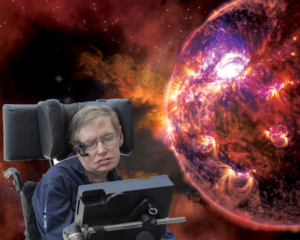
Stephen William Hawking, perhaps the world’s most exceptional scientific communicator, recognized theoretical physicist, mathematician, author and notable researcher who revolutionized the science of cosmology and physics, passed on March 14th this year. Despite being one of the world’s greatest minds, Stephen Hawking was a disabled dependent person who could not walk and talk but had to use a wheelchair and a sensor device that was activated by a cheek muscle allowing him to communicate with people in his surroundings and all across the globe.
One does not need to be an intellectual giant nor learn science to understand the motivational messages embedded in Hawking’s many lectures and speeches about how to overcome adversity. In the same, he details the ways one can dedicate and apply oneself to achieve success and how to never give up against all the odds with the clarity of mind and perseverance. The only requirement, in engaging with Hawking’s teachings and lessons in the domain of overcoming adversities and living an enriched life, is to be human and to appreciate and understand his abilities beyond his disabilities. Hawking carried himself in this world in such a manner and lived his life according to self-acquired wisdom in such a way that even his disability became his ability.
Hawking was not just a disabled person but a person with extraordinary mental efficiency, in fact, he had a divine or suprahuman gift. He was the great spelunker of our universe who healed the dreams of all those who were physically challenged, differently abled and faced disillusionment and heartbreak from not having the proper tools provided to them to transcend their limitations. Hawking taught them to live a dignified life and gave a lesson to all of the humankind about how a person, any person, can achieve success by believing in their abilities by thinking beyond weaknesses and limitations and working with whatever is available.
Hawking gave hope to thousands of disabled people who potentially had lost faith, hope and confidence in themselves because their disability had become a marker of their being and their identity in a deep-rooted manner due to societal perceptions, that it came in the way of who they were. Hawking taught that a disability as much as it may be a part of a person does not mark the heart, spirit, soul and life-force within each person unless they allow it to do so. It was not that Hawking simply gave dignity to disabled people through his public persona and his writings. It was that he showed the entire human world to recognize the dignity that disabled people already had within them but the world was too blind, ignorant or preoccupied to even notice. In the process, he added, perhaps unintentionally, but more so significantly, to the discourses and theories explored in the academic field of Disability Studies.
Here was a person dependent on his wheelchair and on the technological device that allowed him to speak who not only explored the multiple secrets of the universe by contributing to the science of cosmology but also inspired hope by living and coping with his disability. He did not let the ailment that led to his disability cripple his brain, his morale or his will to move forward in life. Instead, he turned to his mind to solve the toughest challenges of modern cosmology, theoretical physics and mathematics.
Needless to say, Hawking has set an example for all of us. He completely defied all the odds to turn dreams into opportunities. By believing in his abilities Hawking became one of the most celebrated physicists of the 21st century. He proved that a person could do wonders despite being physically disabled. He reached the height of his field despite being dependent on his wheelchair and a sound device.
Once in an interview, Hawking said that he lived five decades longer than what doctors had prognosticated. That in itself was a reason that gave him hope to explore his abilities beyond his limitations. He considered every day of his life as his last day and never focused on his disability. It was in 1964, at the young age of 21 years that Hawking was diagnosed with ALS (amyotrophic lateral sclerosis). That time doctors predicted that he would have only three years to live and that he would not make it to his 25th birthday.
Initially, Hawking was depressed over his diagnosis. Later, he decided to set his vision and mind on accomplishing his goals. He wanted to earn his PhD before his death. For that, he considered every single day of his life as his last day, and that in turn motivated him to learn more and more about his field. He contributed to science with his work on gravitational singularity theorems by using Einstein’s general relativity theory and the theoretical prediction that black holes emit radiations (now widely known as “Hawking radiations”). Stephen was absorbed in exploring the infinite expanses of the universe, black holes and the ultimate forces that design the evolution of cosmos.

In 1970, he started working with Roger Penrose, a renowned mathematician of that time. In that time period, he used Einstein’s theory of relative gravity to postulate that our universe started from a state of physical singularity, a point of infinite density. These singularities are considered to be the centres of black holes. A black hole is a region of space having a gravitational field so intense that no matter, radiation or light can escape from it, hence the name “black hole” (coined as a term in 1967 by American astronomer John Wheeler).
Interestingly enough, astronomers like John Wheeler confirmed the existence of black holes. These black holes are thought to lie at the centre of galaxies, including our Milky Way. Before Hawking, black holes were considered the universe’s most mysterious garbage collectors. It was also believed that nothing could escape from their immense gravitational pull. However, Stephen Hawking’s contribution to relative gravity brought about the discovery that something does escape a black hole: radiation. It became one of his most notable achievements (Hawking radiations) and because of his contribution, we came to know that black holes are not even entirely black (they have a faint glow).
Beyond all this scientific, academic and intellectual accomplishments, Hawking was also a very brave person. His one theory predicted that information held within the black hole would be permanently lost once the entity evaporated (black holes are capable of radiating particles and the energy lost through the process causes the black hole to shrink and eventually disappear). When it was shown that this might not be the case, he openly accepted his mistake by making a public announcement about being wrong. By admitting his mistake openly he proved that he was courageous and very humble.
Hawking was not only a notable researcher but also a prolific writer. In 1988, his first book appeared on stands with the title of “A brief history of time”. In this book, he simplified the ideas of his theories. Despite the fact that the book sold more than ten million copies, it is still considered as the greatest unread book in history. With this book, Hawking became an important science communicator, the way Carl Sagan and now Neil deGrasse Tyson are. Apart from his scientifically intensive academic work and research, Hawking invited us to marvel at the poetic greatness of the universe through scientific knowledge expressed in accessible language made understandable to all of us. And he did this all while sitting on his wheelchair, with a paralysis and an extremely minimized ability to move.
This year the world has lost a notable writer, a great thinker, a ground-breaking scientist, and one of the most intelligent people to have arrived into this world. He passed away on March 14th, at the age of 76, on the same day that Einstein was born and on the same that World Maths Day is celebrated. His death was not only a loss to the community of scientists around the world but to the whole world at large, including the universe that he spent a lifetime studying and exploring.
Disability Studies: “Disability Studies scholarship and teaching enhance the understanding of disability by incorporating social, cultural, historical, legal, and political perspectives, including the connections between disability and other identities. Disability is a fact of the human experience, not the exception. Disability Studies centres the experiences of disabled people and emphasizes the role of the disability community in defining problems and evaluating solutions.”
Source: University of Washington, Disability Studies academic program webpage.
Advertisement


